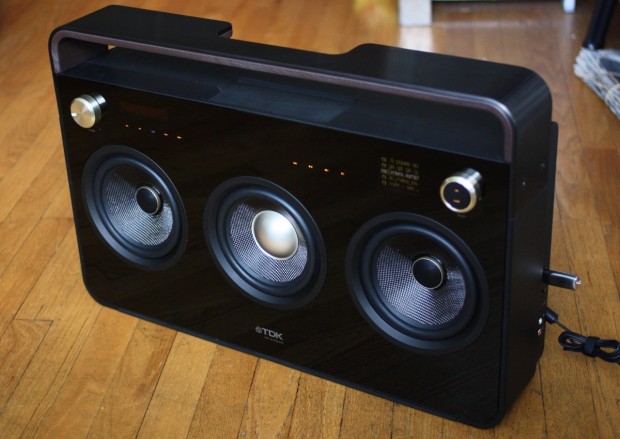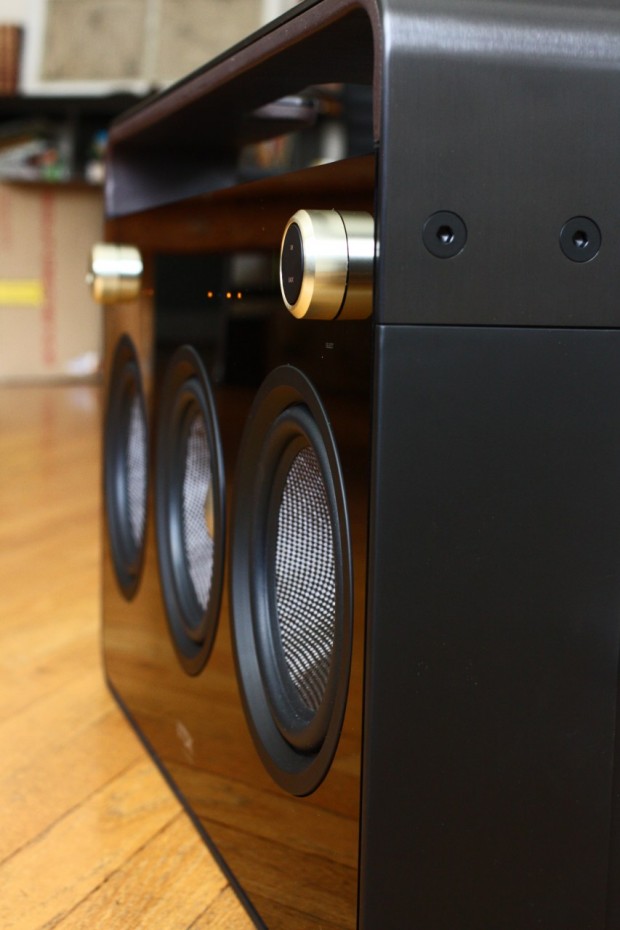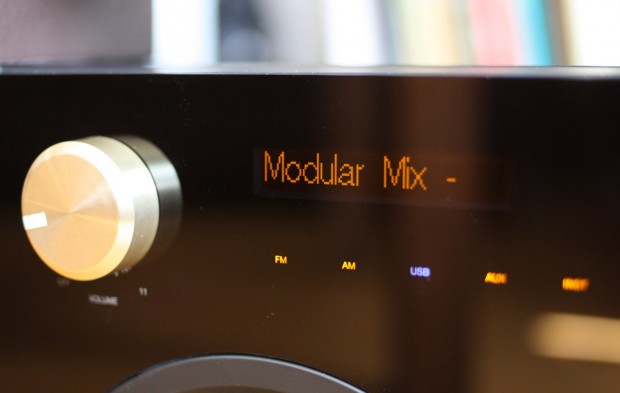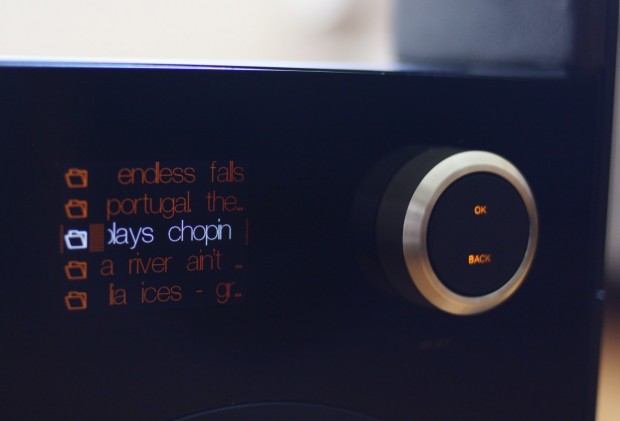
Short version: Beautifully styled, modern, and very loud, but USB issues take this from a cool and functional device to a questionable one. (Update: TDK released a firmware update the day after this review published which fixes the USB issues. I installed it myself and it works perfectly; devices will ship with updated firmware starting now, and owners should be able to download the update at TDK’s site soon. The review has been updated where relevant, but the portions relating to the issue left in for the record.)
Features:
- Two 6-inch speakers plus 6-inch subwoofer
- FM/AM, USB (drive/iPod), 3.5mm, RCA, 1/4″ inputs
- Adjustable EQ
- 35 watts RMS
- MSRP: $499.95
Pros:
- Great, unique look
- Big, powerful sound
- It’s just cool
Cons:
USB port music doesn’t seem to play well- Could use an SD slot/li>
- Displays could be bigger
- Twelve D batteries?
Full review:
 The first thing that needs to be said is that this isn’t a question of value, exactly. Or rather, it’s not a question of whether you should buy this boombox or another boombox. Who even buys a boombox these days? Generally you have your computer speakers on your desk, and perhaps a surround sound system or hi-fi attached to a mixer/entertainment center. But a boombox?
The first thing that needs to be said is that this isn’t a question of value, exactly. Or rather, it’s not a question of whether you should buy this boombox or another boombox. Who even buys a boombox these days? Generally you have your computer speakers on your desk, and perhaps a surround sound system or hi-fi attached to a mixer/entertainment center. But a boombox?
TDK is aiming at the nostalgia crowd, a group of people who used to have boomboxes but now have a little disposable income and a taste for design.
Design
So obviously the first thing you notice about this thing is the design. Portland-based Ziba design really did TDK proud here, creating an easily recognizable, almost instantly iconic look, and one that puts the most sound-related features forward: the speakers. They’re uncovered so you can better see them move, but it’s also worth noting that not putting a grill on them makes them susceptible to kids, pets, and feet.
The design has an admirable symmetry, with the volume/power control on the left and navigation/adjustment on the right. There are little touch-sensitive buttons that appear when applicable and disappear at other times, which gives the device a nice minimalist look, though it slightly disrupts the symmetry. There are two displays, a one-line display on the left that shows song data and/or radio station name. The display on the right is used for navigating your directories on a drive, adjusting the station and EQ, and defaults to a spectrum display when not in active use. The volume dial (which goes to 11 — nice one) is weighty and feels good to spin. I love the finish, too:
The color theme throughout is orange and white, and overall it’s very attractive. The piano black finish is attractive but attracts dust and fingerprints, as you can see in my pictures, and I swear I just wiped that thing off right before I took the shots.
The two screens, however, could really stand to be quite a bit larger. Song data is almost always truncated and must be shown in several sequential screens. Not so much a big deal for song and artist display, but navigation can be troublesome if you have more than a few directories. Why not make them both the same size — about 1.5″x4″ would do it, and we’re not talking about some expensive touchscreen here, just a low-res, limited-color display. I know the attention is supposed to be on the industrial design, TDK, but let’s be honest, there’s bright, blinking info at all times and it really should be either bigger or smaller. You can’t make it smaller without making it non-functional — so make it bigger.
Despite the small screen size, navigation really isn’t that bad. Text is clear and attractive, and although I would have preferred it show ID3 tags instead of filenames, that’s really a matter of taste. It doesn’t really “accelerate” if you spin it faster, though, which feels like it would make sense.
It’ll function plugged in, or with twelve D batteries. I guess boom boxes always needed that kind of power, but man, that’s rough. There’s a handle for carrying, which is convenient, and a little grippy rubber pad for you to put your MP3 player on. Good attention to detail all around, and the build quality is hard to fault.
I would have liked an SD card slot, though. Why not? It’s cheap, makes your device more self-contained, and attracts techie types. Integration with over-the-air signals would have been nice, too, although you could easily rig something up through the analog in.
Sound
The predominant sound of this boombox is big, warm, and loud. Wattage ratings aren’t anything to go by, by the way. These three speakers are more than enough to completely saturate a room with thumping bass and serious noise. Depending on your input (more on that in a second) you can really make this thing push air. We’re not talking phone book-shredding or anything, but if you were worried that a (relatively) compact system can’t make enough noise, you can safely shelf those worries.
 It’s definitely aimed at booming sound, though: although it doesn’t distort or muffle something like unaccompanied piano, it does universally emphasize the lower end. Fortunately, the EQ (really only adjusting the treble and bass) is easily accessible at any time, and you can switch between party mode and Chopin mode with a couple twists of the wrist. EQ presets would have been appreciated, but it would also have complicated things for only a small convenience. It’s not a mixer or amp, it’s a boom box.
It’s definitely aimed at booming sound, though: although it doesn’t distort or muffle something like unaccompanied piano, it does universally emphasize the lower end. Fortunately, the EQ (really only adjusting the treble and bass) is easily accessible at any time, and you can switch between party mode and Chopin mode with a couple twists of the wrist. EQ presets would have been appreciated, but it would also have complicated things for only a small convenience. It’s not a mixer or amp, it’s a boom box.
Actually, speaking of amps, it’s also compatible with any instrument with a 1/4″ out. My disused electric guitar worked perfectly well with it, and while it’s no tube amp, it’s an easy setup for practice, though to be honest you might want to increase the single before it goes into the TDK, as the input level seemed pretty low.
The following portion of the review described an issue with the USB input that caused it to clip. TDK has rectified the issue with a patch, and USB sounds fine now. The conclusion portion has been changed to reflect this as well.
For that matter, the line in input level seemed low as well, while whatever controller handles music on USB drives obviously has the input set at maximum. I played the same song on my Zune and on a USB stick after noticing some clipping issues, and not only did I have to set the volume twice as high when using the 1/8″ in, but the sound was clear all the way through, while on the USB drive it clipped almost constantly. I tried a couple different drives, same result. TDK, you need to turn that sucker down. How about a firmware update?
This USB issue seems to extend, unfortunately, to iOS devices, which it supports via the same port (it ships with a 30-pin connector). It’ll even charge your iPhone or iPod, though my iPad would play music but not charge.
Conclusion
So is it worth the money? If you plan on using USB media with it, I can’t recommend it. If this USB issue weren’t present, this would make a great sound system for a music-orientated small household or shared area where people are always plugging in their iPods or what have you to provide a collective soundtrack to a home. The sound is great for parties and general non-audiophile use if you use the analog inputs or radio, and the 1/4″ port is appreciated, but without USB it’s not really a complete product. If TDK addresses this issue (or if this review unit can be shown to be an exception) then I’d say get thee to the TDK-ery if you feel you can spend half a grand on a nicely-designed second sound system. Until then, though, hold off.
Conclusion (updated)
Now that the USB issue has been fixed, there’s nothing to stop me from recommending this other than the fact that it’s rather expensive and not for audiophiles who value clarity over power. It’s well-designed, fun, and fairly versatile. Is it worth $500? That’s not something I can decide for you, but let me put it this way: if you think it’s worth $500, you won’t be disappointed with the performance. If you don’t think it’s worth $500, it’s not for you.


